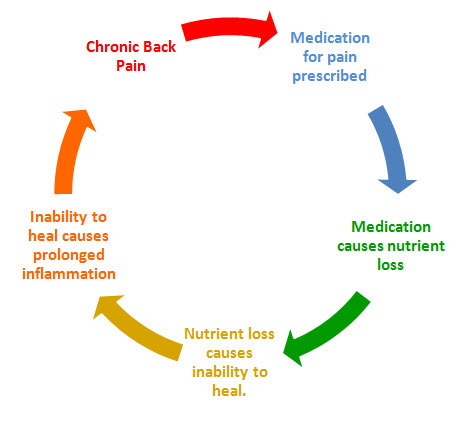Mainstream treatment for osteoporosis is not the answer…
Mainstream treatments for osteoporosis shown to cause more
problems than they help. Recent evidence links taking
bisphosphonate medications such as Actonel and Fosamax to a
number of side effects including, osteonecrosis of the jaw, atrial
fibrilation, gastrointestinal pain, and dyspepsia (indigestion).
References:
Black DM, Delmas PD, Eastell R, Reid IR, Boonen S, Cauley JA, et al.
Once-yearly zoledronic acid for treatment of postmenopausal
osteoporosis. N Engl J Med 2007;356:1809-22.
Bauer DC, et al. Upper gastrointestinal tract safety profile of
alendronate: the fracture intervention trial. Arch Intern Med.2000 Feb
28;160(4):517-25.
Bisphosphonates and osteonecrosis of the jaw: a retrospective study.
[Endocr Pract. 2007]
Nature and frequency of bisphosphonate-associated osteonecrosis of
the jaws in Australia. [J Oral Maxillofac Surg. 2007]
Osteonecrosis of the jaw induced by orally administered
bisphosphonates: incidence, clinical features, predisposing factors and
treatment outcome. [Osteoporos Int. 2007
Osteonecrosis of the jaw in cancer after treatment with
bisphosphonates: incidence and risk factors. [J Clin Oncol. 2005]
Outcomes of placing dental implants in patients taking oral
bisphosphonates: a review of 115 cases. [J Oral Maxillofac Surg. 2008]
Dr. Osborne’s Comment:
Medications for the treatment of osteoporosis are simply band aids
that do not address the true causes or contributing factors for the
disease. Bisphosphonates prevent your body’s ability to get rid of
old worn out bone. When your body is unable to remove old bone, it
cannot replace it with new bone tissue. Although bone density
appears to improve with the use of a bone scanner, the quality of the
existing bone is compromised. Read my report on osteoporosis to
better arm yourself with knowledge and prevent bone loss from
affecting your health.
Following these simple tips can go a long way in preventing bone loss:
Perform weight bearing exercises on a daily basis.
Eat an abundance of high quality organic or local grown fruits
and vegetables.
Eliminate refined and processed foods from your diet.
Get adequate sunlight for your skin type without the use of
sun screens as they block vitamin D synthesis.
Nutritional deficiencies
Don’t smoke or subject yourself to second hand smoke.
Strongly limit caffeine (less than 100 mg/day) and alcohol
intake.
Avoid medications that effect vitamin and mineral metabolism
such as steroids, NSAIDS, and acid lowering medications.
During your annual check ups, have your doctor perform lab
work to identify nutritional deficiencies.
Have your doctor genetically screen you for osteoporosis risk
early in life so that you can make appropriate lifestyle
modifications.
Mainstream treatments for osteoporosis shown to cause more problems than they help.
Recent evidence links taking bisphosphonate medications such as Actonel and Fosamax to a number of side effects including, osteonecrosis of the jaw, atrial fibrilation, gastrointestinal pain, and dyspepsia (indigestion).
References:
- Black DM, Delmas PD, Eastell R, Reid IR, Boonen S, Cauley JA, et al. Once-yearly zoledronic acid for treatment of postmenopausal osteoporosis. N Engl J Med 2007;356:1809-22.
- Bauer DC, et al. Upper gastrointestinal tract safety profile of alendronate: the fracture intervention trial. Arch Intern Med.2000 Feb 28;160(4):517-25.
- Bisphosphonates and osteonecrosis of the jaw: a retrospective study. Endocr Pract. 2007
- Nature and frequency of bisphosphonate-associated osteonecrosis of the jaws in Australia. J Oral Maxillofac Surg. 2007
- Osteonecrosis of the jaw induced by orally administered bisphosphonates: incidence, clinical features, predisposing factors and treatment outcome. Osteoporos Int. 2007
- Osteonecrosis of the jaw in cancer after treatment with bisphosphonates: incidence and risk factors. J Clin Oncol. 2005
- Outcomes of placing dental implants in patients taking oral bisphosphonates: a review of 115 cases. J Oral Maxillofac Surg. 2008
 Dr. Osborne’s Comment:
Dr. Osborne’s Comment:
Medications for the treatment of osteoporosis are simply band aids that do not address the true causes or contributing factors for the disease. Bisphosphonates prevent your body’s ability to get rid of old worn out bone. When your body is unable to remove old bone, it cannot replace it with new bone tissue. Osteonecrosis occurs because the weakened bone in the jaw develops micro fractures. Although bone density appears to improve with the use of a bone scanner, the quality of the existing bone is compromised. Read my report on osteoporosis to better arm yourself with knowledge and prevent bone loss from affecting your health.
Following these simple tips can go a long way in preventing bone loss:
- Perform weight bearing exercises on a daily basis.
- Eat an abundance of high quality organic or local grown fruits and vegetables.
- Eliminate refined and processed foods from your diet.
- Get adequate sunlight for your skin type without the use of sun screens as they block vitamin D synthesis.
- Don’t smoke or subject yourself to second hand smoke.
- Strongly limit caffeine (less than 100 mg/day) and alcohol intake.
- Avoid medications that effect vitamin and mineral metabolism such as steroids, NSAIDS, and acid lowering medications.
- During your annual check ups, have your doctor perform lab work to identify nutritional deficiencies.
- Have your doctor genetically screen you for osteoporosis risk early in life so that you can make appropriate lifestyle modifications.
 ==>> Click Here For More Information <<==
==>> Click Here For More Information <<== Dr. Osborne’s Comment
Dr. Osborne’s Comment




 A chemical used in the production of polycarbonate plastics, bisphenol A (BPA), is raising concern over its effects in fetuses and children, according to a draft report from the NIH. The report, from the National Toxicology Program, concludes that BPA presents “some concern” that exposure of fetuses and children “can cause changes in behavior and the brain, prostate gland, mammary gland, and the age at which females attain puberty.” The report cites “negligible concern” that BPA exposure leads to birth defects. Polycarbonate plastics are used in, among other things, bottles for water and infant formula or breast milk. The draft report says that infants and children have the highest intakes of BPA in the population. The Canadian government may declare the compound toxic as early as this week, an anonymous source told the New York Times.
A chemical used in the production of polycarbonate plastics, bisphenol A (BPA), is raising concern over its effects in fetuses and children, according to a draft report from the NIH. The report, from the National Toxicology Program, concludes that BPA presents “some concern” that exposure of fetuses and children “can cause changes in behavior and the brain, prostate gland, mammary gland, and the age at which females attain puberty.” The report cites “negligible concern” that BPA exposure leads to birth defects. Polycarbonate plastics are used in, among other things, bottles for water and infant formula or breast milk. The draft report says that infants and children have the highest intakes of BPA in the population. The Canadian government may declare the compound toxic as early as this week, an anonymous source told the New York Times. Dr. Osborne’s Comment…
Dr. Osborne’s Comment…





